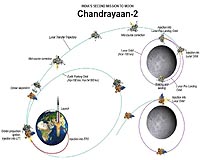 |
Sydney, Australia (SPX) Nov 20, 2009 2009 will go down in history as one of the greatest years for lunar exploration. We were stunned by the discovery that the sun-drenched lunar surface, once thought to be bone dry, hosts small traces of water! Orbital observations of the Moon's polar regions revealed areas that are probably the coldest regions in the solar system, with temperatures plunging below that of Pluto! With all this as precursors, the stage was set for the dramatic October plunge of the LCROSS mission, expected to generate a plume of water vapour as it impacted near the Moon's south pole. The discovery of water by this mission was no big surprise. What was surprising, though, was just how much the modestly sized spacecraft managed to detect. Estimates are still being revised, but even a conservative review of the data suggests there could be tons upon tons of water waiting for us. Clearly, this is enough to be useful for life-support, fuel generation and industrial purposes. But further discoveries await us. LCROSS was like a mere pinprick on a vast region, and we are not sure how its results can compare to other suspected ice-laden regions. We don't even fully understand the region explored by LCROSS itself. How was the water ice structured before it was blown skyward? Was it deep beneath the ground? Was it close to the surface? Was it fairly pure or mixed with regolith? Much of its initial properties would depend on how it was formed, and we don't even know that! Cometary impacts have been the long-favoured theory for ice deposits, but the abundant quantities discovered by LCROSS are giving added strength to other theories. Some suggest venting from the lunar interior, or chemical reactions in lunar rocks. Comparing the formation of water on the sun-exposed lunar surface could provide insight into the formation of the polar deposits. There's probably no single explanation, and debate will rage for decades, just like some of the Moon's other mysteries. What's next? Observations from orbit will continue from the Lunar Reconnaissance Orbiter, launched in tandem with the LCROSS mission. What's really needed is some close studies on the ground. Landers must deploy rovers to explore these regions. We need to dig. We need to drill. We need to perform chemical analysis in-situ, with instruments that can take a sample inside. At some point, experimental refineries could be landed by robot spacecraft. These could dig small samples of water-laden regolith, and attempt to process clean, potable water. Adding this water into a small biological payload, such as a small tank of microbes, would be an interesting test. Other instruments could attempt to make hydrogen and oxygen from the water. At some point, competitions could be run for designing equipment to process the ice, just as we have seen high-profile contests for flying prototype lunar landers on Earth and digging lunar regolith. But we can't expect to produce a reliable design for such a device, until we properly understand the ice itself. Our next objectives in lunar exploration should be clear by now, even if our understanding of lunar ice is not! Dr Morris Jones is the author of The New Moon Race, available from Rosenberg Publishing (www.rosenbergpub.com.au). Share This Article With Planet Earth
Related Links LCROSS mission Mars News and Information at MarsDaily.com Lunar Dreams and more
 Chandrayaan-II Mission Over By 2012-13
Chandrayaan-II Mission Over By 2012-13Bangalore, India (PTI) Nov 09, 2009 Chandrayaan-II moon mission, which will help in analysis of mineral composition and undertake terrain mapping of the moon, will be completed by 2012-13, Project Director of Chandrayaan Dr M Annadurai has said. "The Rs 425 crore project will be completed by 2012-13. As opposed to Chandrayaan-1 which was a moon orbiter, in Chandrayaan-2, the two moon rovers will actually land on the moon ... read more |
|
| The content herein, unless otherwise known to be public domain, are Copyright 1995-2009 - SpaceDaily. AFP and UPI Wire Stories are copyright Agence France-Presse and United Press International. ESA Portal Reports are copyright European Space Agency. All NASA sourced material is public domain. Additional copyrights may apply in whole or part to other bona fide parties. Advertising does not imply endorsement,agreement or approval of any opinions, statements or information provided by SpaceDaily on any Web page published or hosted by SpaceDaily. Privacy Statement |